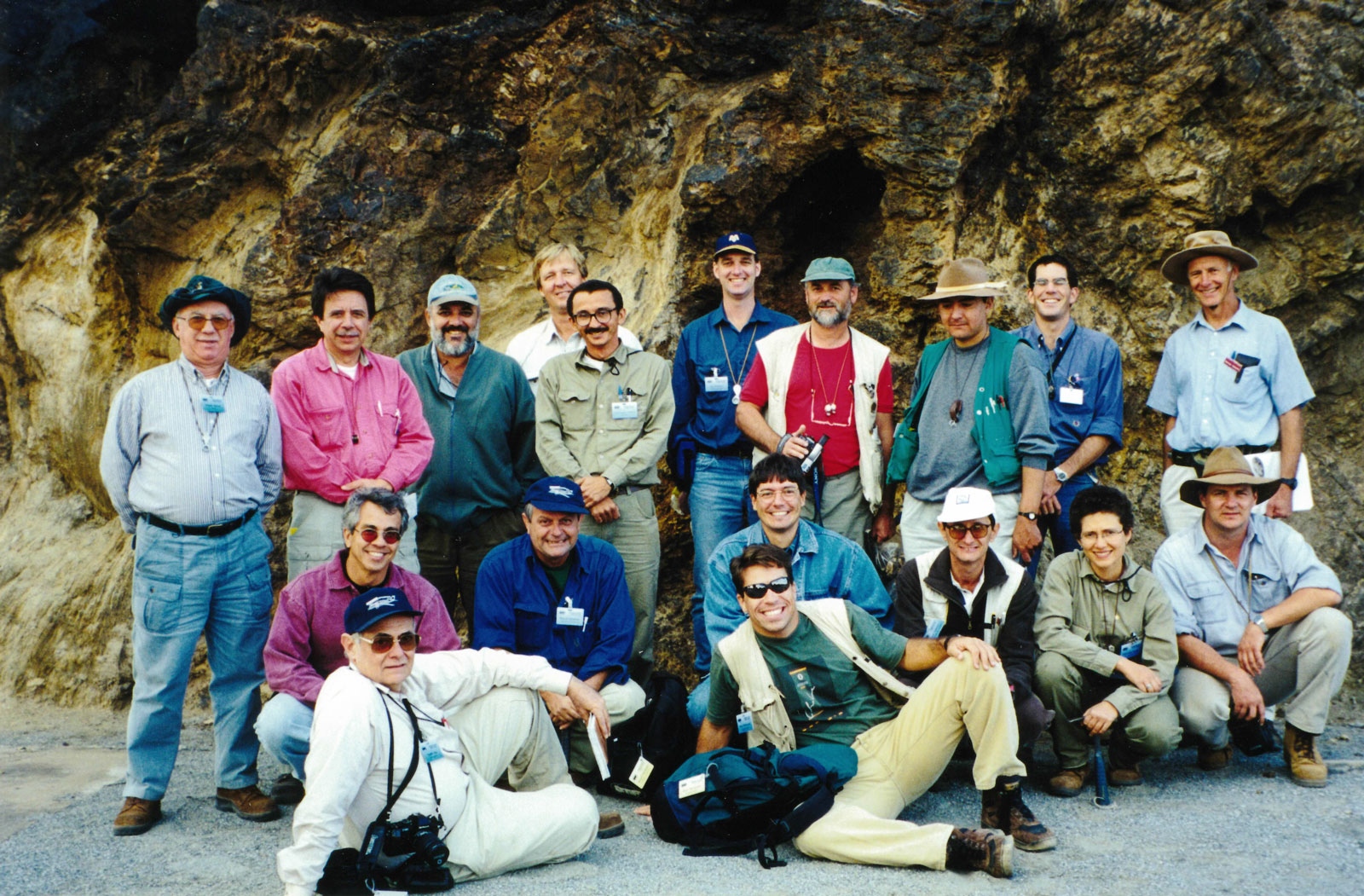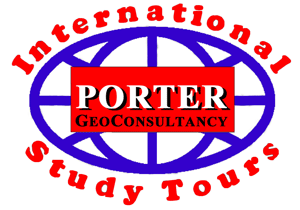| |||||||||||
| |||||||||||
| |||||||||||
|
Image: Module 2 group on the Broken Hill gossan.

By Mike Porter
In the velvet darkness, the walls sparkled and glittered like a gem strewn Aladdin's cave as the narrow light beams of the group's cap lamps played erratically back and forth.
But they saw no precious gems and jewels here. Instead, there were the myriad dark reflective facets of a mass of coarsely crystalline galena and sphalerite - the ore minerals of lead and zinc - interspersed with red garnet and grey quartz. Over more than a century the mighty ore deposit exposed in this cross-cut has been the heart of the Australian mining industry, spawning two of the world's great mining companies. In doing so, those companies have realised the alchemists dream of converting base metals into gold. This of course was Broken Hill, now perhaps in it's autumn years. Within Western A-lode, on the 18 level of Pasminco's Southern Operations Mine, the 18 geologists of the AMF OzTour '99 International Study Tour marvelled at this, one of the most fabulous orebodies in the world. It was however, just another of the 16 major base and precious metal mines on the tour itinerary, spread over six states and territories of Australia. Surrounded by darkness, they stood in a tightly bunched group, their orange overalls and reflective vests silhouetted and lit by the glow and flash of the constantly moving lamps on their white hard hats. They studied the ore face by the light of their cap lamps, taking notes and photos, animatedly discussing what they saw, eagerly knocking off specimens with their g-picks, and asking questions of the four accompanying Pasminco geologists. The ambient noise, a rapid percussive vibration that emanated from the face and filled the air, was the sound of jumbos elsewhere in the mine drilling blast holes to break the ore. At regular intervals there was a loud growl followed by a whiff of diesel exhaust as a low profile dump truck, hauling another 40 tonnes of ore in the main drive, passed the entrance to the cross-cut. The group, comprising geologists from North and South America, Africa and Australasia, had arrived at the mine gate just after 8:00 am that day. They had first been taken to the geology office and given a brief introduction before being kitted out to go underground, and then down the main shaft at 9:00 am. The stop at which they now stood was the first of a well planned series that covered the various aspects of the occurrence of the zinc-lode ores and the enclosing country rocks. They were back on the surface at 11:30 am, and after changing, had a session in the model room with Pasminco staff. Then, over lunch they were treated to an excellent, concise, but comprehensive presentation by Chief Geologist Colin Lutherborrow, which lasted until 1:30 pm. The group was next taken to the core yard to look at a series of drill holes demonstrating the ore and host rocks, including lead-lode mineralisation. By just on 3:30 pm they were on the bus to the airport to depart for Cobar, the next stop. The previous day, also in Broken Hill, had been taken up by a workshop, focussing progressively down from the Curnamona Craton, to the Willyama Block, to the Broken Hill district and deposit. That day, which had provided invaluable background for the mine visit, was presented by Barney Stevens, Principal Research Scientist of the NSW Department of Mineral Resources. It had comprised a morning in the office with maps, images and rocks, followed by an afternoon in the field looking at exposures of the zinc and lead lode horizons, the gossan and enclosing rock types. However, for those now flying east to Cobar on the fast charter aircraft thathad taken them around Australia, the tour was in its nineteenth day, with just two more remaining. It was also the ninth day of the second module that had started in Darwin on the evening of Tuesday May 18. It would end on Saturday May 29 after visiting Hellyer in Tasmania, the ninth mine on the module, and the last of sixteen of the most important base and precious metal ore deposits in Australia that made up the full tour. The mine visits were supported by four overview seminars and field workshops presented by renowned experts. The first module had started in Adelaide at noon on Sunday May 9 with anoverview workshop, and ended in Geraldton, Western Australia on the morning of Tuesday May 18, when the 6 members taking this module alone had left the 18 strong group. Upon farewelling the departing members in Geraldton, the main group had flown north to Darwin, lunching en-route on the water front at Broome. On arrival in Darwin they were joined by another 6 who would take the second module only. As is now the norm for this International Study Tour series, the participants were from around the world. They came from three countries in South America, three in Africa,from North America, South-east Asia and Australia, and represented a wide diversity of experience, knowledge and perspective which they contributed to discussions on tour. They were from the more progressive companies who appreciate the need to develop their key staff to maintain a competitive advantage over their less forward looking rivals. In the three weeks of the full tour, they travelled together for some 11 500 km, mostly in two chartered, fully pressurised, twin turbine Cessna Conquest aircraft. These cruised at 550 km/hr, and an altitude of 30 000 feet, devouring the long distances, and landing directly at mine airstrips. The size of the tour group was partly determined by the 18 seats available on these aircraft, but also by the number that could be accommodated on underground visits, and by the effective size of a group that must interact and work together. The tour had in fact been over-subscribed, with a number of applications foreach of the modules of necessity being declined. A Joint Tour
While the detailed planning, organisation and management of OzTour '99 was all undertaken by the AMF, it was in fact a joint tour, conducted in cooperation with the Agencia para o Desenvolvimento Technologico da Industria Minera Brasileira (ADIMB of Brazil).
The content and itinerary were initially negotiated between ADIMB and AMF. ADIMB had promoted the tour through its membership, representing the bulk of the mineral industry in Brazil. All of the participants from outside of Brazil were recruited by the AMF. ADIMB is a Brazilian organisation, somewhat analogous to both the AMF and AMIRA. It's mission is to promote and develop the technical and scientific capacity, and human resources of the Brazilian mineral industry. As such it is involved in the further education of mineral industry professionals, and with promoting research. Eleven of the tour participants were from ADIMB member companies. They took part in all of the tour, from its commencement in Adelaide on Sunday 9 May, up to and including the visit to Broken Hill on Thursday 27 May. The full tour, and the second module, ended two days later on Saturday 29 May, after taking in a further two mines. Future tours will be similarly jointly promoted, with the next, Pacific Gold '99 being supported by the AMF, ADIMB, the Geological Society of South Africa and theMineral Deposits Division of the Geological Association of Canada. The Ore Deposits
The theme of the tour was "Key Australian Base Metal and Gold Deposits". It encompassed a representative selection of the country's most important mines.
The first module concentrated on "Base Metals and Gold in the Archaean and Proterozoic Shield of South Western Australia". It commenced with WMC's giant Olympic Dam copper-uranium operation in the Gawler Craton of northern South Australia. Next came four nickel orebodies in the Yilgarn Craton of Western Australia, covering each of the main exploited styles. These were the Mt Keith disseminated sulphide mine (WMC), the massive sulphides of Kambalda (WMC), the silicate laterites at Murrin Murrin (Anaconda Nickel) and the oxide laterites at Cawse (Centaur Mining and Exploration). Two important gold mines were included, the KCGM Super Pit in Kalgoorlie and the Bronzewing mine of Great Cental Mines. The final visit was to the Normandy Golden Grove copper-zinc mine in the Murchison Province of the Yilgarn. The second module focussed on "Base Metals and Gold in the Proterozoic and Phanerozoic Mobile Belts of Eastern Australia". It began with the great northern Australian trio of sediment hosted zinc-lead-silver deposits, the HYC orebody at McArthur River (MIM), the Century Project (Pasminco) and the Hilton-George Fisher and Mt Isa Lead mines at Mt Isa (MIM). Next were the Mt Isa copper orebodies (MIM) and the Ernest Henry copper-gold deposit (MIM-Pasminco). Then the high grade metamorphic hosted lead-zinc-silver mines of Cannington (BHP) in Queensland and Broken Hill (Pasminco) in New South Wales. These were followed by the transgressive, sediment hosted massive sulphide zinc-lead-silver deposit at Elura (Pasminco), also in NSW, and the Hellyer volcanic hosted copper-lead-zinc-silver-gold orebody of Western Metals in Tasmania. Each visit entailed a briefing on the ore deposit, its geological setting, the mineralisation and mining, followed by an opportunity to study the ore and host rocks in the mine. At most operations, drill core through the ore and surrounding country rock was also available, while in addition at some, surface traverses of the deposit were conducted, over and away from the mine. At a number of sites this was the first group to have been granted a visit. Almost without exception the visits were superb, a reflection of the professionalism of the Australian industry. The AMF and all of the tour participants are indebted to the companies and mine staff for their cooperation, and the time and hospitality they extended to the group. Seminars, Workshops and Experts
In addition to the mine visits there were four seminars and field workshops, and a half day field traverse, designed to provide an overview of the geology and mineralisation of the regions visited.
The first was presented by Primary Industries and Resources SA who provided five expert speakers for a half day seminar at the AMF in Adelaide covering South Australia, and the Gawler Craton in particular. In Perth, high level presentations were delivered at a full day seminar. They included informed speakers from the Geological Survey of WA, the Centre for Strategic Mineral Deposits at the University of Western Australia, the CSIRO, and the CRC-LEME. These covered the tectonics and geology of the Yilgarn and Pilbara, the Archaean gold deposits of WA, the development and controls of nickel mineralisation and the development and behaviour of metals in the regolith. The Geological Survey of WA had earlier conducted a regional traverse across the Norseman-Wiluna Greenstone Belt just south of Kalgoorlie. In Mt Isa, well known Brisbane based consultant Geoff Derrick provided a comprehensive overview of the geology and metallogeny of the Mt Isa Block and McArthur Basin, followed by a field traverse of the key hosts and gossan zones at Mt Isa. At Broken Hill, Barney Stevens of the NSW Department of Mineral Resources gave an excellent overview of the geology and mineralisation of the Curnamona Craton, Willyama Block and Broken Hill district, followed by a traverse of the key lithologies, lode horizons and gossan outcrops at Broken Hill. The Series Continues
This was the seventh such tour conducted by the AMF over the last two and a half years. In all, these have visited more than 85 of the world's most important ore deposits, in North and South America, Africa, Europe, Asia and Australasia.
These tours have been attended by geologists from all of those continents and from most of the worlds most important mining and exploration companies. Four future tours are currently in various stages of development. These are: Pacific Gold '99 taking in more than 20 of the most important gold and gold-copper deposits around the Pacific margin, in the Western Pacific, Western North America and Andean South America, as three separate modules, in September-October 1999. NewGold '99 which will immediately follow the New Generation Gold Deposits conference in Perth in late November. It will visit new discoveries and mines in WA, some of which are the subject of presentations at the conference, as well as established and better understood mines in the same districts. Nickel 2000 that will visit the worlds most important nickel deposits, both laterite and sulphide, as three modules in mid 2000. Africa 2000 taking in the gold deposits of East and West Africa, in two modules, in late 2000. Mike Porter of Porter GeoConsultancy Pty Ltd designed, organised and led this International Study Tour for the Australian Mineral Foundation.
PorterGeo Home
| More on This Tour
| Other Tours
| About AMF
| |||||||||||











